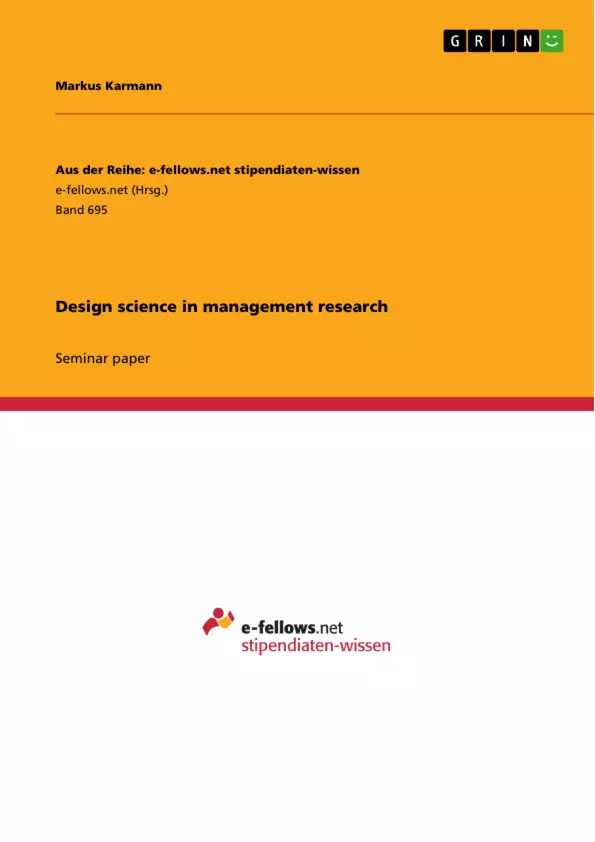Management research is constantly criticized in the academic community to have very little impact on managers in practical life. This problem is highly discussed in academic circles and often referred to as the utilization problem (van Aken, 2004) or the rigor-relevance dilemma/gap (Fincham & Clark, 2009; Avenier, 2010). The problem is that the conducted management research is either scientifically verified, but not relevant for practice or practically relevant but not scientifically verified (van Aken, 2004).
There are various explanations for this problem. Many researchers claim that a lack of sufficient communication presentation of management research is the root of the problem (Davies, 2007). This is in accordance with the so-called “knowledge transfer problem”(Shapiro, Kirkman, & Courtey, 2007). Others blame the little relevance of management research for practitioners (Denyer, Tranfield, & van Aken, 2007), which is reflected in the “knowledge production problem” (Shapiro, Kirkman, & Courtey, 2007). Furthermore, management research is claimed as “too descriptive” (van Aken, 2004), which means that management science is only describing and analyzing but not actually providing solutions to problems. Lastly, some researchers describe management research as too fragmented in terms of research groups and knowledge products (Denyer, Tranfield, & van Aken, 2007). The researchers claim that too little cooperation between researchers restricts knowledge solutions and weakens the position of management research.
In order to increase relevance of management research and to create a clear academic identity (Tranfield & van Aken, 2006) academic community calls for new research approaches, particularly the so-called design science approach (van Aken, 2004). Design science helps to actually design solutions to field problems but still keeping academic relevance in order to fulfill Pettigrew’s idea of accomplishing both, academic and practical relevance (Pettigrew, 1997).
This paper aims to give the reader an overview on design science and its (possible) practical relevance in management research. First of all, the author will present the ideas of design science and its main determinants of major research contributors. Afterwards, a comparison between design science and the often with design science presented action research and evidence-based management approach is made. Chapter 3 will then present two examples of executed research and applied design science.
Inhaltsverzeichnis (Table of Contents)
- 1 Introduction
- 2 Background
- 2.1 Overview on design science
- 2.2 Comparison with action research and evidence-based management
- 2.3 Methodological/philosophical categorization
- 3 Executed research and applied design science
- 4 Further application and future contributions
- 5 Conclusion
Zielsetzung und Themenschwerpunkte (Objectives and Key Themes)
This paper aims to provide an overview and a “sense” of design science and its practical relevance in management research. It explores the ideas of design science and its main determinants, comparing it with action research and evidence-based management. The paper also classifies design science based on its research philosophy/methodology and presents examples of executed research and applied design science.
- Design science as a research approach to address the relevance gap in management research
- Comparison of design science with action research and evidence-based management
- Methodological and philosophical categorizations of design science
- Examples of executed research and applied design science
- Future directions and potential contributions of design science
Zusammenfassung der Kapitel (Chapter Summaries)
Chapter 1 introduces the problem of management research lacking practical impact, highlighting the "utilization problem" and the "rigor-relevance dilemma." It discusses various explanations for this issue, including insufficient communication, lack of relevance, and fragmented research groups. Design science is presented as a potential solution to increase relevance and create a clear academic identity.
Chapter 2 provides a comprehensive overview of design science, exploring its main determinants and contrasting it with action research and evidence-based management. It delves into the methodological and philosophical categorization of design science.
Schlüsselwörter (Keywords)
The main keywords and focus topics of this paper include design science, management research, action research, evidence-based management, rigor-relevance dilemma, utilization problem, knowledge transfer, knowledge production, and academic relevance.
- Quote paper
- Markus Karmann (Author), 2013, Design science in management research, Munich, GRIN Verlag, https://www.grin.com/document/213085



